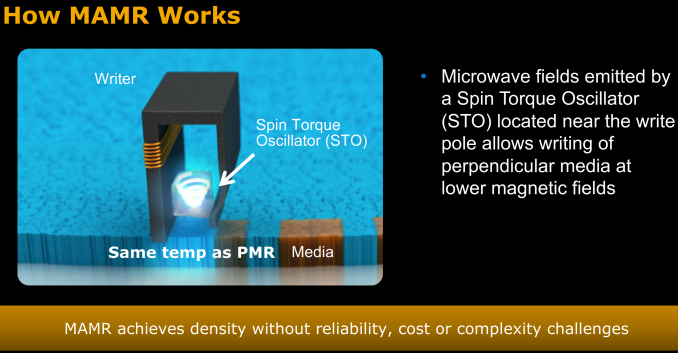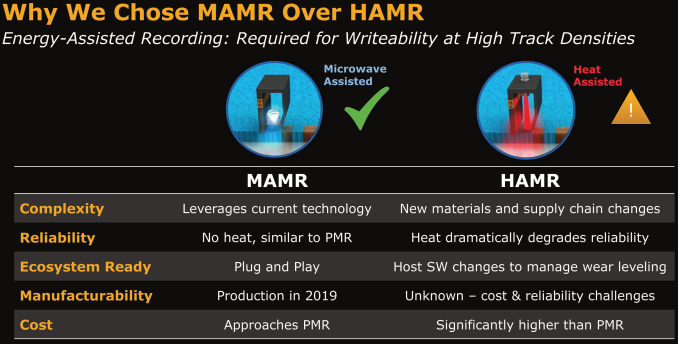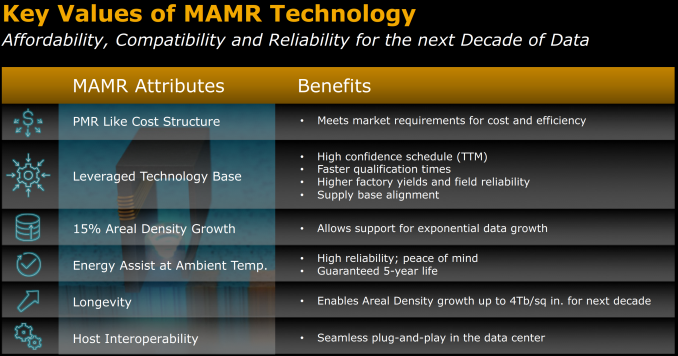Western Digital Stuns Storage Industry with MAMR Breakthrough for Next-Gen HDDs
by Ganesh T S on October 12, 2017 8:00 AM ESTMicrowave Assisted Magnetic Recording (MAMR)
The WD Breakthrough
Western Digital's Microwave Assisted Magnetic Recording (MAMR) drives use platters very similar to those in the current-generation PMR drives*. This means that the innovation to enable MAMR is mainly to do with the heads that perform read and write operations.
As part of the MAMR design, WD pointed out to its shift to the damascene process for building the bit grains as the key enabler for the MAMR breakthrough. The process allows them to fabricate a spin torque oscillator (STO) capable of creating precise energy fields without any additional overheads. The embedded oscillator in the head is tuned to generate microwaves with a frequency of 20-40 GHz, and this provides the 'energy-assist' to make it easier to write to the bits (technically it lowers the coercivity of the underlying recording media).
* Current drives use an aluminium substrate with a cobalt-platinum layer.
WD pointed out that MAMR requires absolutely no external heating of the media that could lead to reliability issues. The temperature profiles of MAMR HDDs (both platters and drive temperature itself) are expected to be similar to those of the current generation HDDs. It was indicated that the MAMR drives would meet all current data center reliability requirements.
Based on the description of the operation of MAMR, it is a no-brainer that HAMR has no future in its current form. Almost all hard drive industry players have a lot more patents on HAMR compared to MAMR. It remains to be seen if the intellectual property created on the HAMR side is put to use elsewhere.
Western Digital has talked about timeframes for the introduction of MAMR drives. They had working prototypes on display at the press and analyst event yesterday. WD's datacenter customers have their own four to six month qualification cycle, and MAMR drives for that purpose are expected to be out towards the middle of next year. Production-level HDDs based on MAMR technology are expected to start shipping in 2019.
Western Digital sees plenty of value in MAMR, and it is not hard to see why. MAMR technology allows for the bit densities of individual platters to scale to more than 4 Tb/sq.in. WD believes that it is well-positioned to bring 40TB drives by 2025 using MAMR alone.
Technologies such as SMR and TDMR are complementary to MAMR. Currently, WD does not use TDMR in any shipping enterprise drive, and SMR is restricted to a few host-managed models. It is possible that some MAMR drives will use those technologies to achieve higher capacity points compared to conventional drives. WD's working prototype on display was a helium drive (HelioSeal), but, WD again stressed that helium is not a compulsory requirement for MAMR drives. It was also confirmed that drives of 16TB and more would have to be MAMR-based.
In 2005, when the shift from longitudinal recording to PMR happened, most vendors managed to release drives based on the new technology within a few years of each other. The shift to helium in 2012, though expected by everyone in the industry, proved to be a big win for HGST - they had the markets that focus on high-capacity, or low-power, or low TCO to themselves for almost three years before Seagate eventually caught up. Toshiba is yet to release a helium drive publicly. It is going to be interesting to see how Seagate and Toshiba respond to this unexpected MAMR announcement from Western Digital.
The players in the hard drive industry have a robust cross-licensing program, and it is highly likely that other manufacturers will not face significant patent bottlenecks in bringing out MAMR drives on their own. WD stressed that the development is a multi-year effort, particularly if the heads are still being manufactured in the old dry pole process.
High-volume mature hard drives are often manufactured with the help of third-party suppliers - such as Showa Denko for the recording media and TDK for the heads. In the case of the MAMR drives, WD mentioned that all the components are being designed and manufactured in-house. It is possible for the competition to catch up faster if some of the third-party manufacturers are further along in their own R&D. In particular, TDK has been investing in MAMR R&D recently too. Toshiba has also shown interest in the same, but it is not clear how far along they are in the commercial development cycle. Currently, we believe WD has a clear lead in MAMR technology. It just remains to be seen how long it takes for the competition to catch up.














127 Comments
View All Comments
AbRASiON - Thursday, October 12, 2017 - link
Ok great, but when can I buy a 10, 12 or 14TB drive for under 220$ US? :(Zim - Thursday, October 12, 2017 - link
Where is the comment from the person who made $1000's last month working from home? Maybe she's sick or had an accident. I'd sleep more soundly if someone could look in on her. Thanks!Magichands8 - Thursday, October 12, 2017 - link
AIDSArbie - Thursday, October 12, 2017 - link
@Zim +3trivor - Thursday, October 12, 2017 - link
If you are setting up your own video server and have 100s or even 1,000s of video files (currently only 480P, 720P, and 1080P) then I expect to fill up my 8 TB HD in a couple more years. That doesn't include any 4K video (which may include 1.5 Mbit (or more) audio in lossless formats like Atmos, DTS-MA, DD True HD). If you don't currently do it (or only have a few ITunes or XBox Video downloads) you don't know what you are missing. My wife refuses to watch a video unless it has been digitized and all "extra" intro and credits have been removed. When we watch videos it is always from hi quality rips (for the most part the video quality is high enough to be "almost indistinguishable from originals). That usually translates into 4 GB/hour of 1080P, 1 GB/hour of 720P/480P video and audio. While it may not satisfy audiophiles it looks quite nice on my brand new LG 55OLEDB6 which is generally considered to be one of the finest TVs on the market right now. I have been far less tolerant of low quality content (especially older DVD rips of 480P (or lower in some cases) than ever before even though the LG TV does an outstanding job of upscaling lower quality content to 4K (3840x2160P).foobaz - Thursday, October 12, 2017 - link
You are very lucky to have a wife who appreciates and benefits from your hobby. :-)someonesomewherelse - Saturday, October 14, 2017 - link
You're overestimating the time it takes to fill up. I have a 13.58 TB btrfs array which is already at 11.80 TB usage and it's less than a year old. I try to only use 1080p x265 encodes but these aren't always available.mazz7 - Thursday, October 12, 2017 - link
A very nice interesting article, anandtech ftw to educate tech enthusiast :)stux - Thursday, October 12, 2017 - link
Enjoyed the article. Thanks :)AnTech - Friday, October 13, 2017 - link
Bring SSD (faster, larger and cheaper). Once you try SSD, you do not want rotational mechanical disks, even for free!